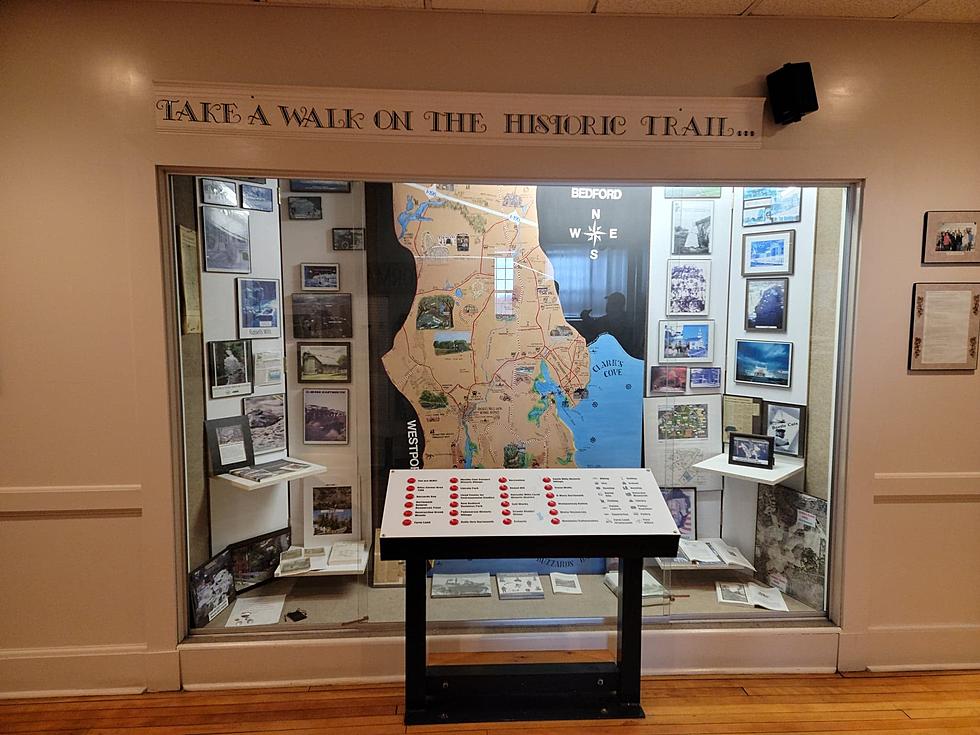
Dartmouth Display Honors the Town’s Wampanoag History
For all the controversy that has surrounded the use of an American Indian logo for Dartmouth High School’s sports teams, one constant part of the narrative on all sides has been this: the town deeply respects its connections to the Wampanoag people.
Those connections run deep, as it’s hard to imagine Dartmouth being what it is today if not for its first Native population, long before the English settlers arrived.
“It was installed several years ago, by a gal who was a clerk in one of the departments,” said Judith Lund of the Dartmouth Historical Commission. “It’s based on a lot of things that the historical commission did over time, and some things she did on her own. I think she or her husband wired it all up. I think it’s an intriguing thing.”

The Dartmouth Town Hall’s walls are utilized to showcase much of the town’s history, including exhibits on parts of town such as the history of Padanaram Village, Russells Mills, and more.
“There are a lot of pictorials and information around Town Hall, if people take the time to look at it and read it,” Lund said.
Nothing is more in-depth and interactive, however, as the display that sits by the Assessor’s Office and across from the elevator and rest rooms. It features a large, hand-painted map of the town, inviting people to “Take a Walk on the Historic Trail.” There are different paths to follow and visual representation for everything from the town’s Native beginnings to its Quaker settlement to Lincoln Park to UMass Dartmouth.
There are buttons that visitors can press to hear narration about all these different aspects of the town’s history, listed alphabetically, including Destruction Brook Woods, Hixville Four Corners, Round Hill, Smith Mills and more. They are read by people important to preserving the town’s history.
One of those narrators is Edith Andrews, a member of the Wampanoag Tribe of Gay Head (Aquinnah) that still has a presence in Dartmouth to this day. She is the mother of New Bedford City Councilor Naomi Carney, Aquinnah tribal leader Cheryl Andrews-Maltais, and Clyde Andrews, who designed the current Dartmouth Indians logo.
“The Wampanoag Indians are the people of the first light,” her narration begins.
She tells the story of her people, of how they lived on the shores in the warmer weather in wetus, also known as wigwams, and how they would plant crops of corn, squash and beans while also fishing and hunting. In the winter months, they would move into the inland forest and stay in longhouses, with multiple families gathered in each one.
“We lived in harmony with all seasons,” Andrews says.
She also discusses how the arrival of the Puritans led to problems between the Wampanoag people and the English settlers, after they had previously enjoyed many years of friendly relations with the earlier-arriving Pilgrims.
“(They) purchased a huge tract of land in 1652 from Ousamequin (also known as Massasoit), chief of the Wampanoag Indians, and his oldest son Wamsutta. This purchase, called Old Dartmouth, included Westport, Dartmouth, Acushnet, Fairhaven, and New Bedford,” Andrews says in the narration. “The land transaction was purchased for clothing such as cloaks, pairs of breeches, stockings, shoes, cloth, blankets, metal items, axes, iron pots, some shillings and a few other goods. These things would only benefit a few individuals.”
Unfortunately, not all Wampanoag people were able to partake in those items received, but all were ordered to leave Old Dartmouth.
“The deed included a clause stating that all Wampanoag Indians had one year to leave the area,” Andrews says. “Some Indians left, but others refused to leave because of their ancestral heritage and quite a number of Wampanoag Indians had already embraced Christianity. I am proud to say the Wampanoag Indians are still here.”
Her final statement in the recorded narration is something that everyone should follow, something that comes from her people but still resonates today: “Walk in peace.”
Dartmouth's History Trail Display Inside the Town Hall
Buildings Featured in the New Bedford Pathways Historical Walking Tours
Remembering the Great SouthCoast Flood of 2010
More From WFHN-FM/FUN 107









